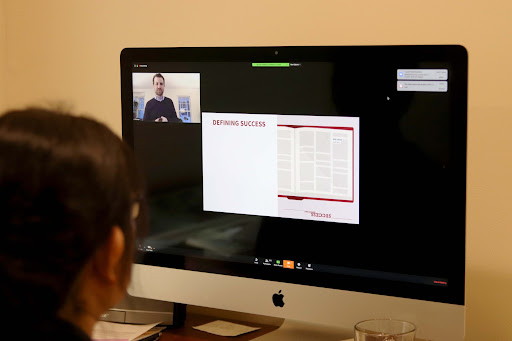Stanford survey results highlight student disengagement
March, 2020
On March 23, Jon Kleiman, a Senior School Program Director for Challenge Success, presented the results from the Stanford Survey of Adolescent School Experience — taken earlier this year by PHS students — via a Zoom call, looking at goals for student health and the effects of previous changes to the administration. This survey investigated the mental health of PHS students by collecting data on their stress levels, hours of sleep, amount of homework, and time for leisure activities.
“We decided [to start administering] the survey back in 2016 because we were noticing that a lot of [the students] were stressed out and complaining about a lack of sleep. They were reporting a lot of homework each night, very little free time, and disengagement with school,” said Principal Jessica Baxter.
The survey, which 90 percent of the students at PHS took, was aimed to provide concrete data to the administration in order to make change.
“We just wanted confirmation of what we were seeing [in our students]. I think it's good to have actually really good data from a [large portion of the student body],” said Baxter. “We use data to make decisions here, and [talking to] a few kids may or may not be representing the larger group of students.”
Due to the results of the 2016 and 2018 surveys, the administration made many changes in an attempt to alleviate the stress students experience. These surveys have been important in showing the administration the effectiveness of such changes.
“We've done a lot of changes over the past couple years with our bell schedule and the later start time, [among other things]. So we wanted to see if what we were implementing was beneficial to the [students],” said Baxter. “What we found from the survey this year is that [after moving] the start time up a half-hour [students] are actually reporting [an increase of] more than a half-hour of sleep each night, which is really, really good.”
Despite the effect of previous changes, the results of the 2020 survey still concern Baxter; on average, students are reporting 6.8 hours of sleep a night, with 2.7 hours of homework each day. The majority of students, 59 percent, believe that half to all of their homework is busywork and doesn’t help them learn the material.
“The other thing that we've been working on is homework,” said Baxter. “We're working with staff to [mainly] give assignments that are essential to the learning, because [although] the hours [of homework] that [students] were reporting went down this year, which is good, kids still perceive a lot of their homework as busywork.”
Baxter also encourages students to be mindful of the amount of work they should expect when choosing their courses. To help students make their decisions, the administration released homework time estimates by class earlier this year.
“[To reduce student stress] we also need families to do their part and kids to do their part. Right now, kids need to understand that they shouldn’t complain about workload if they’re just going to load their schedules up with AP courses,” said Baxter. “This is a collective effort, and to reduce [student stress] we really need kids to understand what they’re signing up for.”
Baxter stresses the importance of flexibility of the administration and its policies concerning student mental health.
“We’re always open to [change]. We have this current schedule, we have certain initiatives that we're working towards, but we’re always open to modifying things and making things work for staff and students and families,” Baxter said.